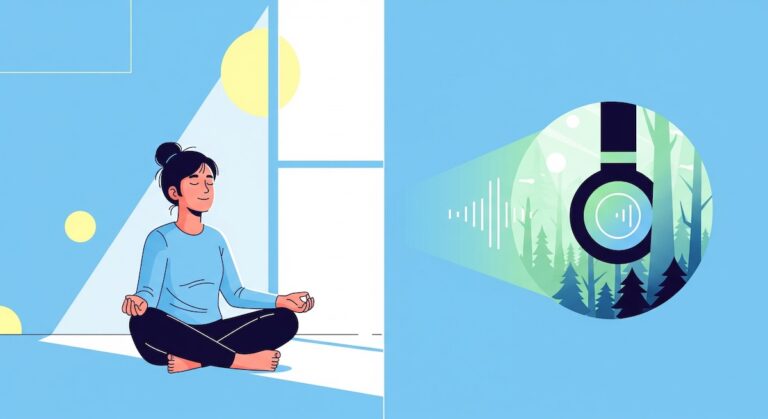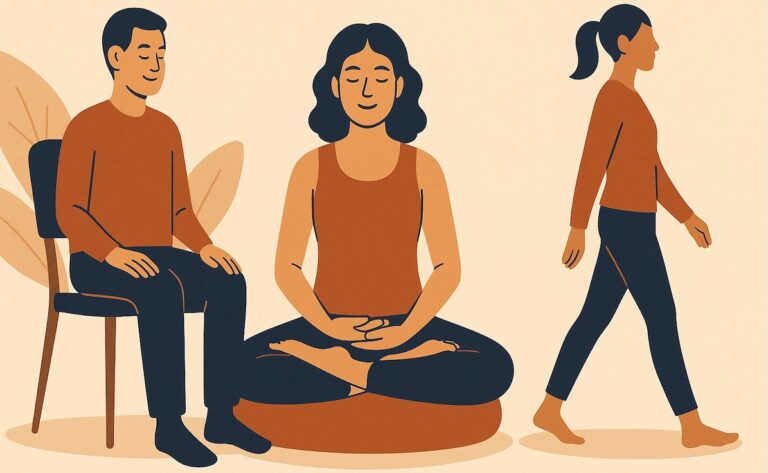Unseen Powerhouse
In our relentless pursuit of well-being, we often overlook the most fundamental, always-available tool: our breath. More than just sustaining life, the breath is a direct portal to influencing our nervous system, emotional state, and cognitive function. Meditation breathing techniques, or pranayama (in the yogic tradition), harness this power intentionally. This comprehensive guide delves deep into the science, methods, benefits, and practical application of key breathing techniques, empowering you to cultivate profound inner peace, resilience, and vitality.
Why Breath Matters: The Science Behind the Sigh
Breathing is unique – it’s both an automatic process governed by the brainstem and under conscious control via the cortex. This dual nature allows us to use intentional breathing to send potent signals to the brain, primarily influencing the autonomic nervous system (ANS):
- The Stress Response (Sympathetic Nervous System): Activated by rapid, shallow chest breathing (common during stress), leading to increased heart rate, blood pressure, and cortisol.
- The Relaxation Response (Parasympathetic Nervous System): Activated by slow, deep, diaphragmatic breathing, promoting calm, digestion, restoration, and reduced inflammation.
Research consistently shows that controlled breathing techniques can:
- Significantly reduce perceived stress and anxiety (Journal of Clinical Psychology).
- Lower blood pressure and improve cardiovascular health (Hypertension Journal).
- Enhance focus, attention, and emotional regulation (Frontiers in Psychology).
- Improve sleep quality and reduce insomnia symptoms (Journal of Alternative and Complementary Medicine).
- Modulate pain perception (The Journal of Pain).
- Boost immune function (PLOS One).
Exploring Key Meditation Breathing Techniques: Methods, Benefits & Quick Steps
Here’s an in-depth look at foundational and advanced techniques:
Diaphragmatic Breathing (Belly Breathing)
- What it is: The cornerstone of most techniques. Involves engaging the diaphragm for deep, efficient breaths, expanding the belly rather than the chest.
- Benefits: Activates the parasympathetic nervous system, reduces stress hormones, improves oxygenation, aids digestion, lowers heart rate, and builds core stability.
- Quick Steps:
- Lie down or sit comfortably, one hand on your chest, the other on your belly.
- Inhale slowly and deeply through your nose, feeling your belly rise (chest should move minimally).
- Exhale slowly through your nose (or pursed lips), feeling your belly fall.
- Focus on making the exhale longer than the inhale (e.g., Inhale 4 counts, Exhale 6 counts).
- Continue for 5-10 minutes.
Box Breathing (Square Breathing / Sama Vritti)
- What it is: Equalizing the length of inhale, hold, exhale, and hold, creating a “box” pattern. Used by Navy SEALs for calm under pressure.
- Benefits: Enhances focus and concentration, promotes profound calm, regulates the nervous system, improves emotional control, reduces panic.
- Quick Steps:
- Sit upright with a straight spine.
- Inhale slowly and deeply through your nose for a count of 4.
- Hold your breath gently with lungs full for a count of 4.
- Exhale slowly and completely through your nose for a count of 4.
- Hold your breath gently with lungs empty for a count of 4.
- Repeat the cycle for 5-10 rounds or minutes. Adjust counts as comfortable (e.g., 3-3-3-3).
4-7-8 Breathing (Relaxing Breath)
- What it is: Developed by Dr. Andrew Weil. A specific ratio emphasizing a long exhale to trigger the relaxation response quickly.
- Benefits: Rapidly reduces anxiety and agitation, promotes sleep onset, calms racing thoughts, lowers blood pressure.
- Quick Steps:
- Place the tip of your tongue against the ridge behind your upper front teeth (keep it there).
- Exhale completely through your mouth, making a “whoosh” sound.
- Close your mouth and inhale silently through your nose for a count of 4.
- Hold your breath for a count of 7.
- Exhale completely through your mouth, making the “whoosh” sound, for a count of 8.
- Repeat steps 3-5 for 4 cycles initially, building to 8 cycles. Do 2-3 times daily.
Alternate Nostril Breathing (Nadi Shodhana)
- What it is: A yogic technique involving alternating breath through each nostril using the fingers.
- Benefits: Balances left and right brain hemispheres, improves focus and mental clarity, reduces anxiety, harmonizes energy (prana), purifies subtle energy channels (nadis).
- Quick Steps:
- Sit comfortably. Rest left hand on lap. Bring right hand to nose.
- Use right thumb to close right nostril. Inhale deeply through left nostril.
- Close left nostril with right ring finger, release thumb from right nostril, exhale through right nostril.
- Inhale through right nostril.
- Close right nostril with thumb, release ring finger from left nostril, exhale through left nostril. (This is one cycle).
- Continue for 5-10 minutes. Focus on smooth, even breaths. End with an exhale on the left.
Kapalabhati Pranayama (Skull Shining Breath)
- What it is: An energizing and cleansing technique involving forceful, rapid exhales and passive inhales. Note: Not recommended for beginners, pregnant women, or those with high BP, heart issues, epilepsy, or recent abdominal surgery.
- Benefits: Energizes the mind and body, clears nasal passages and sinuses, strengthens abdominal muscles, improves lung capacity, stimulates digestion.
- Quick Steps:
- Sit tall with spine straight, hands on knees.
- Take a deep inhale.
- Forcefully exhale by contracting your lower belly muscles sharply inward. The inhale happens automatically as you release the belly.
- Focus solely on the active exhale (approx 1 per second). Start with 20-30 exhales.
- After one round, take a few deep, normal breaths. Repeat 2-3 rounds. Never force.
Lion’s Breath (Simhasana Pranayama)
- What it is: A playful, tension-releasing technique involving a forceful exhale with an open mouth and extended tongue.
- Benefits: Relieves tension in face, jaw, neck, and chest; reduces stress and frustration; stimulates throat chakra; encourages emotional release.
- Quick Steps:
- Sit comfortably (kneeling or cross-legged) or stand. Place hands on knees.
- Inhale deeply through your nose.
- Exhale forcefully through your mouth, opening your mouth wide, sticking your tongue out towards your chin, and stretching fingers wide. Make a loud “HA” sound from your throat.
- Relax face. Repeat 3-5 times.
Ocean Breath (Ujjayi Pranayama – Victorious Breath)
- What it is: Creates a soft, soothing “ocean wave” sound by gently constricting the back of the throat during both inhale and exhale through the nose. Common in Vinyasa yoga.
- Benefits: Increases mindfulness by providing an audible anchor, builds internal body heat, calms the mind, improves concentration, and regulates breath flow.
- Quick Steps:
- Inhale deeply through your nose.
- Exhale slowly through your mouth with an open throat, making a soft “HA” sound (like fogging a mirror).
- Repeat step 2, but close your mouth. Keep the same gentle throat constriction while breathing only through your nose. This creates the characteristic soft hissing/sighing sound.
- Maintain this gentle throat lock during both inhalation and exhalation. Focus on the sound and smoothness.
| Technique | Best For… | Key Benefit | Energy Effect | Difficulty |
| Diaphragmatic | Foundation, Stress Reduction | Deep Relaxation, Better Oxygenation | Calming | Beginner |
| Box Breathing | Focus, Calm Under Pressure | Nervous System Regulation | Balancing | Beginner |
| 4-7-8 | Quick Anxiety Relief, Sleep Aid | Rapid Relaxation Response | Calming | Beginner |
| Alternate Nostril | Mental Clarity, Emotional Balance | Brain Hemisphere Harmony | Balancing | Beginner+ |
| Kapalabhati | Energy Boost, Cleansing | Invigoration, Mental Alertness | Energizing | Advanced |
| Lion’s Breath | Releasing Tension, Frustration | Physical & Emotional Release | Releasing | Beginner |
| Ocean Breath | Mindfulness Anchor, Yoga Practice | Concentration, Internal Focus | Warming | Beginner |
Integrating Breathwork into Your Life: Tips for Success
- Start Small: Begin with 2-5 minutes daily. Consistency is more important than duration.
- Find Your Posture: Sit comfortably with a straight spine (chair, cushion, floor). Lying down is suitable for diaphragmatic practice.
- Focus on the Exhale: Lengthening the exhale is key to activating the relaxation response in most calming techniques.
- Be Gentle: Never force or strain. If you feel dizzy, stop and breathe normally.
- Listen to Your Body: Some techniques may not suit everyone. Honor your limitations.
- Mindfulness is Key: Pay attention to the sensations of the breath – cool air entering, warm air leaving, the rise and fall of your body.
- Consistency Over Intensity: Daily practice yields greater cumulative benefits than occasional long sessions.
- Pair with Meditation: Use these techniques as a foundation for seated meditation or as a practice in themselves.
Beyond the Basics: The Holistic Impact
Mastering these techniques offers more than stress relief. They foster interoception – awareness of internal bodily sensations – crucial for emotional regulation. They cultivate mindfulness, anchoring us in the present moment. They empower us with agency, providing a tool to self-regulate amidst life’s challenges. Breathwork connects the mind, body, and spirit, offering a profound path to holistic health and resilience.
Conclusion: Your Breath, Your Anchor
Meditation breathing techniques are ancient wisdom validated by modern science, offering accessible, powerful tools for navigating the complexities of contemporary life. From the grounding calm of Diaphragmatic Breathing to the focused clarity of Box Breathing and the balancing energy of Alternate Nostril, there is a technique suited to every need and constitution. By consciously engaging with the rhythm of your breath, you unlock the potential to reduce stress, enhance focus, improve health, and cultivate a deep, enduring sense of inner peace. Start exploring today – your most powerful tool for well-being is already within you, one breath at a time.




